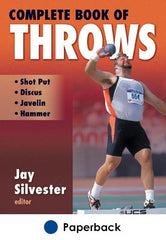Strength and conditioning exercises for hammer throwers
This is an excerpt from Complete Book of Throws by Jay Silvester.
There are a great variety of ways to train the body for better hammer performance. The area of strength and conditioning for the hammer can be broken down into the following disciplines: running, jumps, event-specific exercises, and weightlifting. The emphasis on each of these conditioning activities may vary depending on the time of the year. It is good to have a wide variety of exercises to train with so that your training routine does not become stale and to ensure that you are developing overall athleticism. Many different types of training will be presented in the section. Make sure that you perform each exercise with the highest quality. Start out performing simple exercises and only move on to more advanced exercises when you are comfortably able to do so. Advancing too fast can lead to injury and overtraining. Be careful to stay within your limits.
Running Exercises
Running exercises to improve speed and strength should be kept fairly short to focus on quick explosion and acceleration. Exercises that fall into this category are short sprints over distances of 20 to 50 meters (or yards). Stair sprints and hill sprints can also be incorporated to provide a little more resistance. One-hundred-meter/yard buildups can also be helpful. For the first 20 meters/yards, run at about 30 percent of your maximum speed and then gradually increase your speed over the last 80 meters/yards until you reach 80 to 90 percent at the end of the run.
Plyometric Exercises
Jumps are a very important part of the physical conditioning program for hammer throwers. You can perform jumps over hurdles, up stairs, on boxes, or on the ground. Jumps into a sand pit such as the standing long jump or multiple jumps (either single- or double-legged), which finish with the last jump into the sand, are good beginning jumping exercises. In the case of all multiple jumps, you should keep the time spent on the ground during each jump (amortization phase) to a minimum to allow for a quick, springlike motion. You can also perform multiple jumps in place for height. A good rule of thumb is to perform multiple jumps in groups of 10 or fewer. Too many jumps in succession will lead to poor technique and quality in the last few jumps, which defeats the purpose of the exercise.
STAIR JUMPS
Stair jumps can be performed with either one or two legs. As you become more efficient at jumping up stairs with two legs, you can progress to single-legged stair jumps. Spread your double-legged stair jumps out gradually over a larger number of stairs per jump as your fitness level increases. The same can be done for the one-legged stair jumps as soon as you can perform these jumps in smooth succession. When performing any stair jumps, make sure to stay on the balls of your feet and not let your heels touch the ground between jumps. Ascending stair jumps can also be combined with descending stair jumps. Descending stair jumps are performed by jumping “down” a set of stairs; land on the balls of your feet at the completion of each jump and attempt to land as softly as possible. Descending jumps work the legs eccentrically, whereas ascending stair jumps combine both concentric and eccentric contractions of the leg muscles. When jumping on stairs, always remain in control so you do not become fatigued and fall.
HURDLE HOPS
Hurdle hops and box jumps can be the most advanced of the jumping exercises. Hurdle hops are done in succession. Again, make sure you are performing these jumps on the balls of your feet and not breaking at the waist at the beginning of each jump, which will not allow you to get full hip extension as you begin to leave the ground. When just beginning this exercise, you can add a small rhythmic hop to get your balance between hurdles if you are having trouble clearing each hurdle in succession. Once you are proficient in hurdle jumps at one height, raise the hurdles to the next height. You can also set up hurdles to become gradually higher within a given set (for example, in inches, 33, 33, 36, 36, 39, 39). Hurdle hops should be done in sets of five to eight to avoid having too many jumps in succession. Elite-level hammer throwers (e.g., Tibor Gecsek) have been known to perform sets of hurdle jumps at 42 inches (107 centimeters) or more.
BOX JUMPS
Box jumps can be done in a variety of ways. Rhythmic box jumps are an easy way to get good leg conditioning work in and are exercises that even beginning throwers can handle. These types of jumps consist of front box jumps, side-to-side box jumps, and double-legged box jumps, and are performed with a relatively low box, about 12 to 16 inches (61 to 122 centimeters). You can also perform explosive jumps from the ground onto a tall box. Boxes for these jumps will range from 24 to 48 inches (30 to 40 centimeters) depending on your height and jumping ability. Try to land as softly on the box as possible.


Get the latest insights with regular newsletters, plus periodic product information and special insider offers.
JOIN NOW
Latest Posts
- Assessment of the Atlanto-Axial Joint (AAJ)
- Side-bending Muscle Energy Technique (MET) for the cervical spine
- Ligaments of the vertebral column in the cervical spine
- What are exercise snacks?
- Create positive muscle-strengthening experiences for those with excess weight
- Empower health behavior change through effective communication and motivational interviewing


